Subtotal: $
Checkout-

Neighbors in Rwanda
-

From Mourning to Praise
-

Did the Early Christians Understand Jesus?
-

Hope in the Void
-

Insight: Loving Your Neighbor
-

Insight: Caring for a Neighbor’s Soul
-

Insight: Evangelism vs. Neighbor-Love
-

Needing My Neighbor
-

The Coming of the King
-

Poem: No One Wrings the Air Dry
-

Does Faith Breed Violence?
-

Editors’ Picks Issue 8
-

The Danger of Prayer
-

Eberhard Arnold: an Appreciation
-

Gripped by the Infinite
-

Janusz Korczak
-

Dead Men Live
-

Mondays with Mister God
-

Who Is My Neighbor?
-

Urban Mansions
-

Readers Respond: Issue 8
-

Family and Friends Issue 8
-

Love in Syria

Next Article:
Explore Other Articles:
On a cold night in San Diego’s Little Italy, I was walking to a gallery opening when I passed a homeless man in a doorway. His eyes caught mine before I could glance away. Inside, as I walked around looking at paintings, the man’s face stayed with me. I knew then that I had to do his portrait, and that’s how the series “Invisible People” started.
While we’re often attracted to images of the rich and famous, too many of us tend to look away from people on the other end of the economic spectrum, the homeless. It’s almost second nature for many of us to simply avoid or ignore a homeless person. Often, we act as if the person isn’t there. For this reason, these images are presented larger than life. By encountering a face this size, I want each viewer to be confronted by a visible, visceral human being.
What is the difference between the people portrayed here and the rest of us? Not as much as we think. We wake up each day and go to sleep at night. We have hopes and dreams and plans. We want to be respected. We want to be loved.
As I’ve gotten to know San Diego’s homeless men, women, and children, I’ve come to recognize and admire the incredible character that each of these people possesses, hard earned through years of struggle and survival on the streets. Their nobility, beauty, strength, and vulnerability are plain to see, if only we look rather than turn away.
There are over six thousand homeless people in the San Diego region, and eighteen hundred of them are children. The issue of chronic homelessness is complex, here and elsewhere. I don’t pretend to have any answers, but if this work can raise awareness, perhaps we can begin to generate some solutions. If these portraits help to keep even one child from ending up on the streets, then the effort that has gone into making them will be worth it.
Creating the Portraits
Each portrait starts with a walk through a city, usually San Diego. As I meet people living on the street, I approach them with a great deal of respect. Even though they don’t have a home, they still have a space that they call their own. I explain that I am an artist and that I would like to make a portrait. Some say yes, some say no. If they agree, I ask about their life, their history, and their hopes. I take one to two photographs, without trying to pose the subject in any way except to ask if they can face into the light. I am looking for the most honest portrayal I can get, one that touches on the human condition.
From the photo, I create a charcoal drawing. Once I am satisfied with the sketch, I enlarge it to match the size of a piece of Plexiglas. Most are three feet by four feet, but the largest are nine by twelve. I place the drawing behind the Plexiglas and begin to carve with a flexible shaft drill. It takes six to eight hours to carve each sheet. Then I roll the carving with ink, place a piece of paper over it, and rub the surface to transfer the ink onto the paper. When the ink is dry, the paper is soaked in water and then adhered to canvas stretched over a wood panel. At the top of the piece, I write the name and age of each subject, where we met, and the year and number of the print along with my signature. At the bottom of the image, I paint one of the symbols used by drifters during the Great Depression to relay information about a place to other travelers. I try to express the spirit of each encounter with a specific sign, be it a communication of safety, a warning, or a message like “good road to follow.”
65
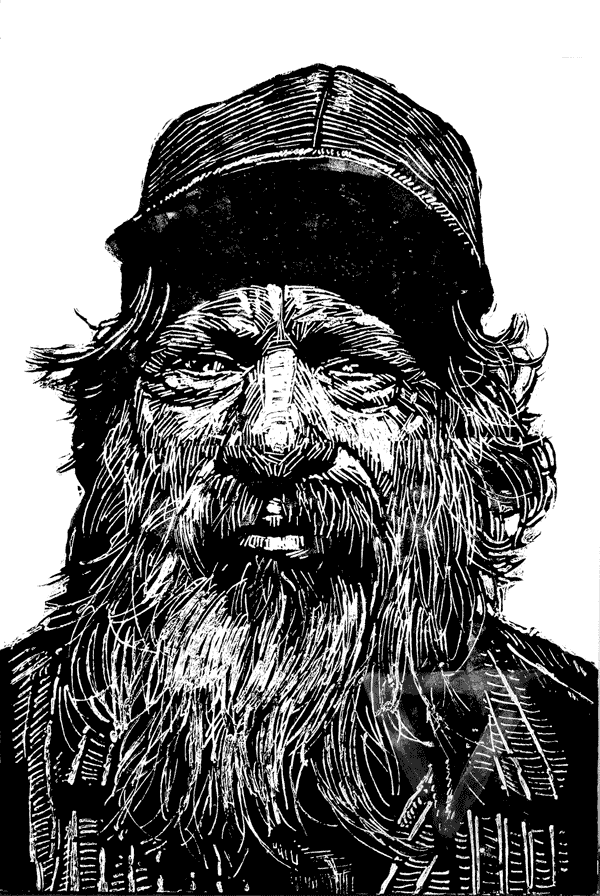
Juan, a quiet and dignified man, has been homeless for nineteen years. Originally from Oaxaca, Mexico, Juan has been a field worker most of his life. His hands are solid and tough.
54
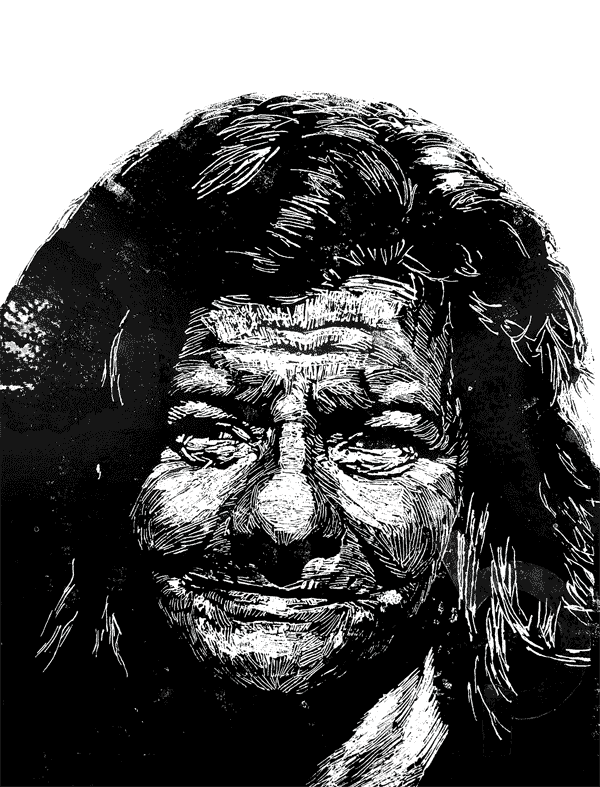
I saw Ruth standing on a busy corner near a thrift store, with a sign asking for money. She was squinting into the morning sunlight. Her face was etched with so much tough living. I introduced myself as an artist and asked if she’d let me do her portrait. She agreed, but seemed nervous, so I thanked her again, then took her photo quickly so that she could get back to what she was doing. I learned nothing about her.
7
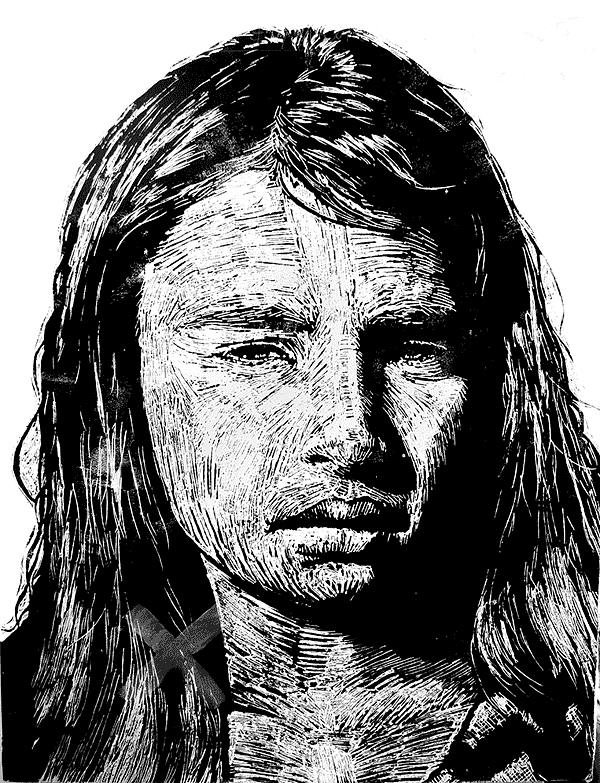
While I spoke with her mother, Bella played with her older sister and younger brother. Their happiness was contagious – a stark contrast to their history. Bella’s mother grew up homeless. Raised by a gang in Los Angeles, she married early. She told me her husband was very violent, so one night she took the three children and escaped. They found their way to San Diego, where they live on the streets and in shelters.
In the future I plan to create more portraits of women and children who are homeless and unsupported. The children have no say, no choice in regard to their circumstances, and often this life is all they have ever known.
Wayne 35
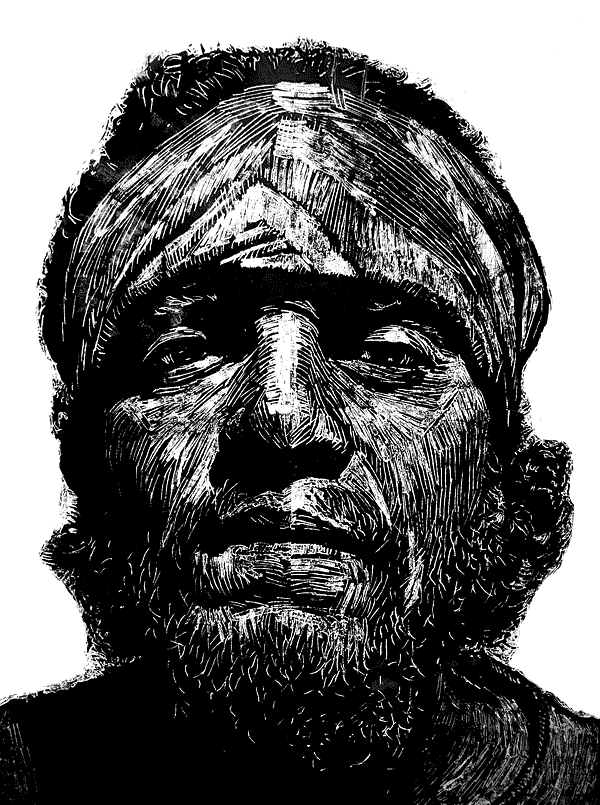
I met Wayne on a sunny day in downtown Los Angeles. I saw him walking – shuffling really. He was slight, missing a shoe, and his clothes didn’t fit him very well. When I got closer, I saw that he had an injured foot, so he couldn’t put a shoe on it. At first, he seemed shy and reluctant to engage with me. He spoke little English and did not make eye contact. Still, he seemed thankful that someone cared enough to listen. We ended up sitting on the curb and talking for a while. I asked him if I could do his portrait, and he agreed to let me take a photo. I gave him some money for food. He told me that his parents were Italian, that he was thirty-five, and that he had come to LA from Hawaii the previous year. He had a cocaine problem. “I used to be big-time me…now I’m sad me,” he said. He seemed like a wounded bird – very fragile, quiet, and sad. He told me, “I want Jesus to save me and take me away.”
46
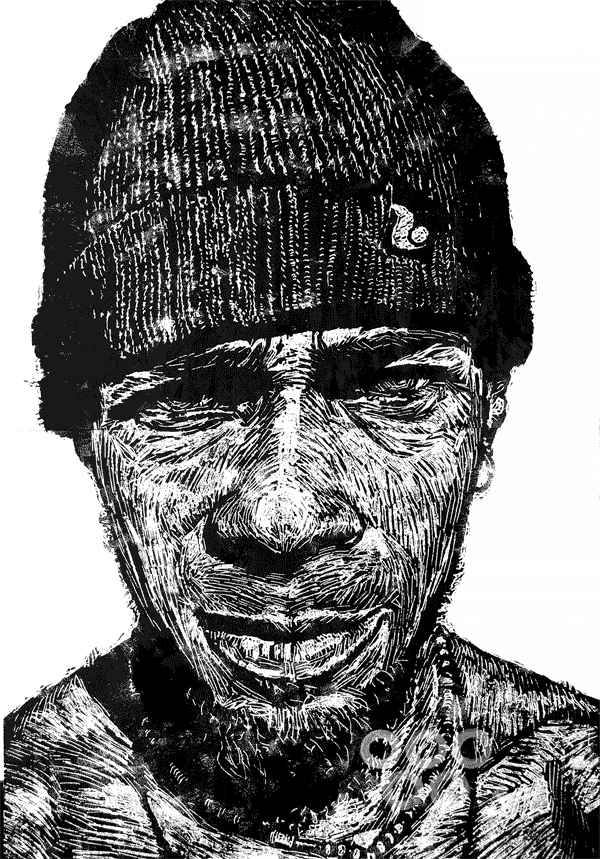
I see Mark often at the freeway off-ramp. He always has a smile and a sign with a positive message. He’s trim and handsome and does not do drugs or drink. When he came to see his portrait on display at the gallery, he told me the city had cleared all his stuff that morning, including his tent. That’s a big deal for a man who has almost nothing, but he didn’t dwell on it. Instead, he reflected on his portrait:
When I look at the picture, I appreciate what I am, who I am. I like that Neil calls it “Invisible People,” ’cause that’s who we are. I hold the sign, I don’t talk to anyone unless I say hi, and you wouldn’t imagine how many brothers have come by me and just cussed me out because they’re mad about the way society’s going, or maybe I put them in an awkward position: “Now I gotta help him, because he’s right there.” People can drive by me like a stop sign. Some choose to talk to me, some choose to get out and pray with me. I’d rather be disliked than be ignored. No one wants to be ignored.
So I choose to do what I’m doing now, just living, surviving…you can call it surviving. I mean, God feeds rats and roaches; he wouldn’t forget me.
The gift that God has for people is something, man. It doesn’t have the spark that the devil has with the Jeeps and Range Rovers, and the bars and things like that, but it’s beautiful. We’re reaching for things that we want, and we never really get what we need. And that’s bad. It passes us right by. We have to understand that this is a material world, and everything has a shelf life for a reason; everything will pass. It might take a while for it to pass, but it passes. So it has to be eternal.…You got to understand that you’re learning something before you go. That saying is a trip, man: “As soon as I died, I started living.” It’s true. We’re learning about somewhere else. It’s not over.
And I don’t think that God made all of these people down here for us to be separated from each other.
Already a subscriber? Sign in
Try 3 months of unlimited access. Start your FREE TRIAL today. Cancel anytime.


































Howard Buskirk
Wisdom that far surpasses what can be found under many a roof, including where I reside. Beautiful article so rich .
LUZ LOPEZDEE
It is in loving and gazing at the face of the poor and homeless will we see Christ who loved them till death. Fear causes us to avoid connecting with them but love conquers fear, therefore we should pray for the courage to love.... luz lopezdee